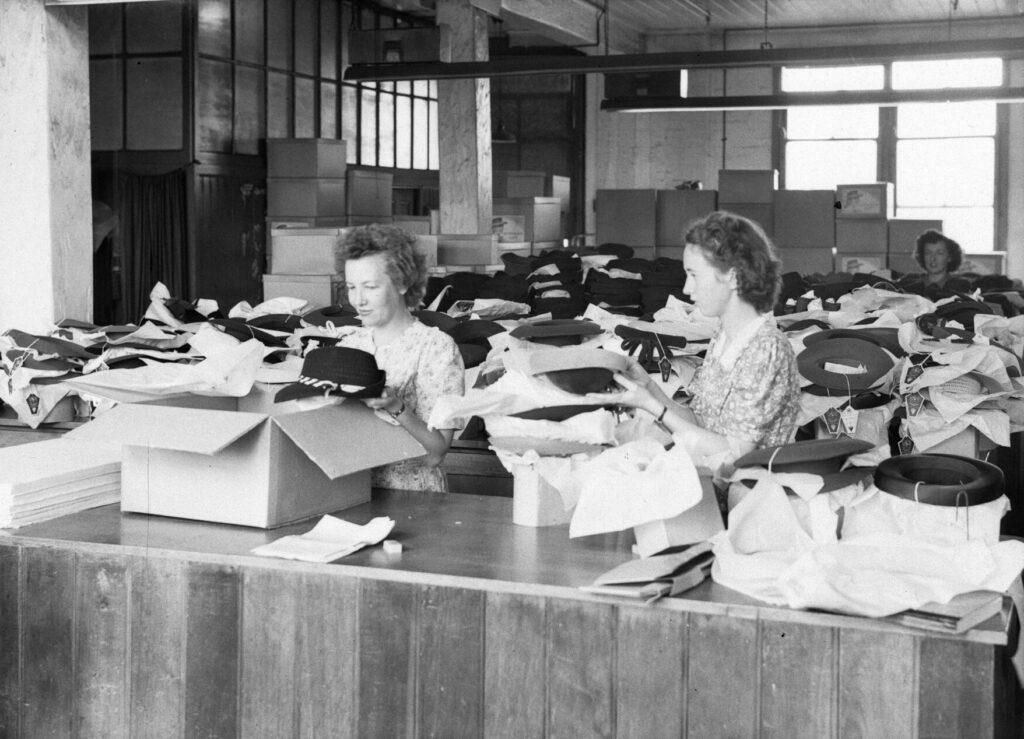
Gutted—Safeguarding our industrial heritage
The fire that engulfed and ultimately destroyed the heritage-listed Henderson hat factory building in Surry Hills is a stark reminder of the vulnerability of historic buildings that are left vacant for extended periods.
On Thursday 25 May 2023, GML staff bore witness to the devastating fire that destroyed the former Henderson hat factory at 7–13 Randle Street, Surry Hills. To see the hat factory and adjacent buildings gutted in less than an hour was confronting and a great loss to Sydney’s industrial heritage.
At this point, the fire has raised more questions than answers about the building’s fire safety provisions and its security.
Hats of the moment
Rolla Crosby Henderson established his first hat factory at Wynyard Square in 1904. The following year he registered the business of RC Henderson in partnership with his father Charles Alfred Henderson. Manufacturing women’s straw and felt hats, the business was relocated to 189 Clarence Street. From there the hat factory moved to 50 York Street and by January 1908 Henderson’s was based in Barlow Street, opposite Central Station.
In April 1910 Charles purchased land in the Central Railway Station Subdivision. Two years later RC Henderson commissioned architect Thomas Pollard Sampson to design an imposing six-storey brick factory building plus basement. The building comprised brick load-bearing external walls with timber columns and beams with steel headstocks internally. The Randle Street factory was used for the manufacture and sale of women’s and children’s felt and straw hats from 1912 until 1954 when the business went into receivership.
The main hat factory building at 11–13 Randle Street, along with adjoining 7-9 Randle Street, was sold in April 1957 and June 1958 respectively. 11–13 Randle Street was occupied by a succession of clothing manufacturers during the 1960s and 1970s. The two buildings were purchased by the current owner, Hanave Investments Pty Ltd, in October 1978.
In 2016 the historic hat factory was set to be transformed into a modern hotel designed by leading architects Tonkin Zulaikha Greer when Hanave applied to the City of Sydney Council to convert three buildings, 7–9, 11–13 and 15 Randle Street, into a 114 room hotel with two additional floors.

Advertisement for Henderson Hats in the Australian Women’s Weekly, 22 February 1947.

Henderson Hat Factory, 1949, GPO 1-46944.

Henderson Hat Factory, 1949, GPO 1-46941.
Heritage lost
Urban and building fires have shaped cities and architecture throughout history.
In 1798 arson was suspected as being the cause of Sydney town’s first fire of note on 1 October 1798, which destroyed St. Phillip’s church. In 1837 the first building fire regulation was introduced by Governor Bourke which prohibited the use of bark as a roofing material. In September the same year, the ‘Act for regulating Buildings and Party-walls and for preventing Mischiefs by Fire in the Town of Sydney’ was passed by the Legislative Council.
The ‘boom years’ of the 1880s saw the erection of numerous commercial structures including warehouses and woolstores and tall buildings. Recognising the increased fire risks posed by tall buildings, the newly established Metropolitan Fire Brigade and several architects, including John Sulman, called for updated laws. Yet by 1889, and despite the introduction of requirements for alarms and sprinkler systems, in many buildings fire protection consisted of nothing more than axes, and buckets of sand and water.
The Anthony Hordern’s fire in 1901 caused several deaths. It resulted in the Metropolitan Fire Brigades Board calling for legislation to limit the height of buildings to 90 feet, and required buildings higher than 60 feet to have external fire-escapes and balconies.
The former Henderson Hat factory building’s vacancy over many years left it vulnerable to trespass, vandalism and ultimately fire. The building’s security had declined. It had become home to people sleeping rough and a canvas for graffiti artists. Skateboarders were often on the roof and seen leaning on the parapet between tricks.
Meanwhile, local residents and community members voiced their concerns to Council.
Dilapidated and vacant heritage buildings pose potential risks to all of us. The building’s destruction brings to the fore the responsibility that owners and local government must have to ensure heritage buildings are maintained and safeguarded while decisions about change are determined.
Who is ultimately responsible for the risk they pose to human life, and who is accountable to the broader community that has lost a significant reminder of our city’s history and heritage?

The destroyed Henderson Hat factory building. Credit: NSW Fire & Rescue.

Anthony Hordern Palace Emporium fire, George Street Haymarket, circa 1901. Photo: City of Sydney Archives.


